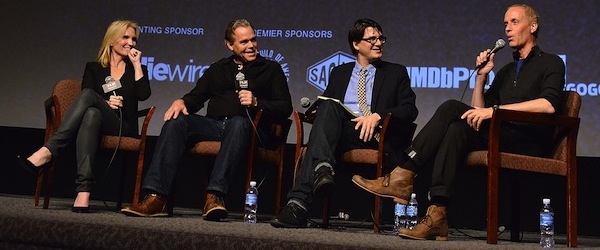“It Had to Be Los Angeles.” Director Dan Gilroy on Nightcrawler’s Untamed Energy

Nightcrawler, screenwriter Dan Gilroy’s directorial debut, is a darkly comedic, sharply satirical thriller starring Jake Gyllenhaal as Lou Bloom, an ambitious videojournalist who cruises around Los Angeles at night, listening to a police scanner and racing to bloody crime scenes to collect horrific footage. This past weekend at the Film Independent Forum, Gilroy, his brother and editor John and his producer Jennifer Fox were on hand for a Q&A following a special advance screening of the film, which premiered at Toronto in September and gets a wide release on Friday.
Moderator Mark Olsen, of the Los Angeles Times, commented on the film’s “ferocious, out-of-control energy.” Gilroy said that energy came from the real-world inspiration for the film. “I discovered that there were people who went out at night and did this job,” Gilroy said. “It’s a kinetic world, so there’s a lot of energy in that.” But it was also from the character himself. Gilroy said “Lou leapt off the page and grabbed me by the throat and demanded that I write him…Lou’s energy was not to be stopped.”
“I’m a big believer that writing is rewriting,” Gilroy said, “usually everything I write goes through a hundred iterations. Nightcrawler was no exception”, but it was otherwise very different from any of his earlier scripts; he described it as reading “like one long run-on sentence.” He also said it was unusual for him that a character demands to be written like this one, but Lou “became a very personal character in the sense that I saw him as a vehicle for ideas and elements that I wanted to get out.”
Lou is desperate for work, which Gilroy said was inspired by the unemployment crisis and particularly by the prevalence of unpaid internships. Gyllenhaal lost 30 pounds to play Lou, biking or running to the set every day and living on kale salad. “It was very much Jake’s idea,” Gilroy explained. “He had this symbolic totem animal of a coyote. And coyotes, as we all know, are perpetually hungry and lean… there’s a very strange energy that emanates—it seems to come from his eyes—where it’s like he’s not just hungry for food.”
Gyllenhaal’s animalistic approach to Lou also informed the cinematography. “We were talking about the idea like in a documentary, an animal will be moving through a landscape,” Gilroy said, “so we were trying to portray Los Angeles as [having] a wild, untamed energy about it and a beauty to it [through] which this character was moving.” Remarkably, they shot the film on both digital and 35mm formats. While cinematographer Robert Elswit is “devoted to film,” Gilroy explained, time and budgetary constraints made it impossible to shoot the whole movie on it. Shot in 28 days, almost entirely at night and in 80 different locations in and around LA, going digital made sense because at nighttime, Gilroy said, “digital has the ability like a sponge to soak up light.” The few daytime shoots were all done on film.
From the very beginning, Fox said, “it had to be Los Angeles,” and they were lucky to receive a $2.3 million allocation from the California Film Tax Credit program. “I find Los Angeles to be physically beautiful,” Gilroy said, “and we wanted to show Los Angeles in a way that you don’t normally see, because Los Angeles is often desaturated on film—a place of cement and freeways and downtown.” They specifically avoided shooting downtown because so many people do shoot there, and used a lot of wide-angle shots and deep focus to bring in the landscape. Gilroy and Elswit weren’t trying to echo the film’s moral darkness in the photography; they believed that would speak for itself. Instead, Gilroy said, “we were trying to make it look beautiful.”
Mary Sollosi / Film Independent Blogger